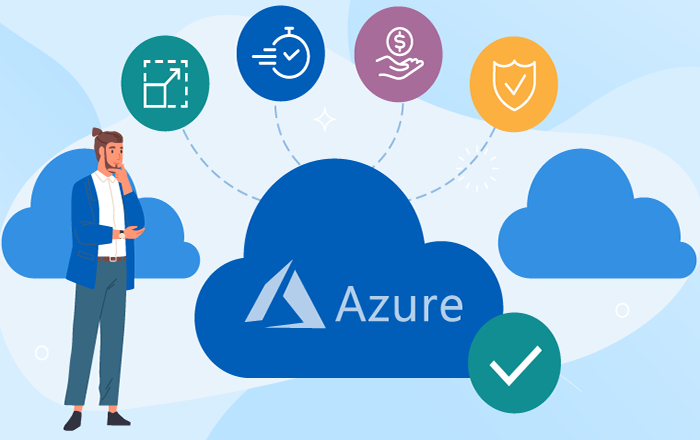07/08/2021Webmaster

Microsoft Azure is Microsoft Infrastructure platform in Cloud. It is used to build your entire business IT infrastructure in cloud with no hardware cost, Easy on, Easy off, pay for what you use. Here it is how it works:
Those who know how a network is designed and works, have heard about servers, desktops and laptops. To make the maximum use of your IT equipment we connect all our devices including routers and switches and printers to a server. This server can control everything and will give you an overview of your entire IT and its users. In a server we define our users by creating accounts for them. We do the same thing for our devices (desktops, laptops, printers). We make sure every user has a password in order to protect their systems and company data. If a desktop breaks down beyond repair, we can retrieve data from the server. Or if a laptop is lost or stolen, we can wipe the laptop remotely and make it unusable.
In short, we control everything in our entire IT infrastructure through the server. Some larger companies have a second server where the data & files are stored or deposited. Some other companies may use databases such as SQL and use a separate server for that purpose only. Hence, a complete IT infrastructure consist of several servers as well as desktops, laptops, routers, switches , printers and so on. This equipment will cost an arm and a leg to purchase and maintain. Depending on the size of your company and the number of users, you will also need an IT engineer to look after your entire IT and maintain the health of your systems. So how much it will all in all cost for IT to run efficiently and securely without giving you hassle and loss of business?! Not to mention that you will still need to pay for software licenses and your IT engineer will have to keep them up to date.
With the advancements in technology and invention of “cloud”, Microsoft came up with the idea of moving all the infrastructure to cloud, so the businesses don’t necessarily have to pay for hardware outright, they can rent it as and when they need it. Same with the use of software and licenses associated with them. There are certain things that you still need to pay for such as internet access, routers, switches, desktops and laptops. But the main chunk of larger part of IT can be rented from cloud.
With this idea in mind, Microsoft created many datacentres across the globe. These datacentres host many many servers. The security and maintenance of servers are performed by Microsoft engineers, not by you. Using these servers, we can create “Virtual” servers, virtual desktops and even virtual networks connecting all those virtual servers & desktops. On each virtual device, you can run the operating system you need and applications you need. Hence, instead of paying for hardware based servers, you rent virtual servers and you pay for them as long as you run them. In other words, you can still own your server even when it is turned off, and while being turned off, you do not pay for it.
Virtual devices are not the only thing Azure offers. You can have virtual storage spaces or distributed virtual databases. The beauty of virtual machines is that should anything go wrong with the server or desktop, in a matter of minutes you can replace them and business gets back to as usual. Imagin this happens to your own in-house server, you need an engineer to start with, then you need possibly parts (RAM, HDD etc), then it will take at least a day to rebuild the server again, install OS and all the updates, security software and applications. Then still you will need to restore accounts, data and such like. How much you will lose in business?
Virtualisation and cloud is the way forward in IT. There is no scape from it. Because of features that it offers:
Who uses Azure most?
Software developers, businesses of all sizes, students, web & application designers, e-commerce stores, bloggers, freelancers – the list is endless.
Terms used with Azure that you need to know;
SaaS : Software as a Service such as SQL database, Office applications, Email clients.
PaaS: Platform as a Service such as servers, storage, networking, database management systems, web based applications, data analysis.
IaaS: Infrastructure as a Service such as migrating your entire IT department to Azure.
To get a better understanding of Azure we invite you to take a look at this video: https://www.globalhostcentre.com/azure